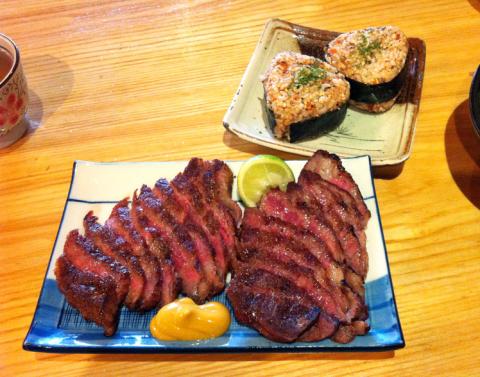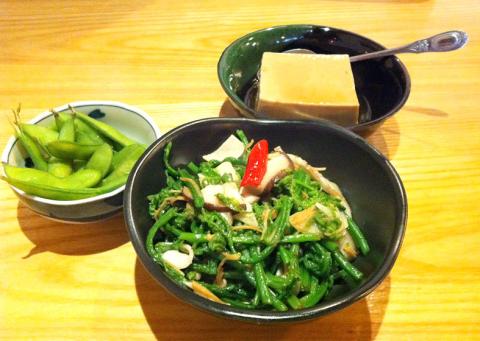Take your shoes off, eat light and leave feeling utterly satisfied after a visit to Weitzuman (味自慢), an izakaya near Jingmei MRT Station (景美捷運站). The izakaya, Japan’s version of a tapas bar, is meant to be an after-work destination where friends and colleagues share small, savory dishes and wash the food down with sake and beer. With its welcoming atmosphere and a menu of grilled, deep-fried and cold dishes, Weitzuman fits the description well.
The food is great. There was not one dud among the handful of dishes ordered on a recent visit. Fresh sashimi (NT$350 for a small plate, NT$480 for a large serving) is available as at most sit-down Japanese eateries, but there are many more interesting choices.
My dining companion and I did well by following the friendly waitstaff’s suggestions, which included several house recommendations listed on the menu. The “field mushrooms with mountain fern vegetable” (野菇山蕨, NT$160) was a delectable stir-fried dish, with thin and tenderly cooked slices of shitake and golden-needle mushrooms serving as a nice complement to the shanjuecai (山蕨菜), a vegetable with a crunchy stalk and a mild flavor.

Photo: David Chen, Taipei Times
The homemade sesame tofu (手工胡麻豆腐, NT$100) was a revelation: The dish arrived looking like a plain, ho-hum block of soft tofu, but were we in for a surprise. This concoction, made with crushed sesame seeds, had us laughing out loud with pleasure from the very first bite. The savory, nutty flavor of the sesame seeds was a perfect match for the creamy, mousse-like consistency of the tofu. Don’t leave the restaurant without trying it.
Weitzuman is refreshingly unpretentious and has the kind of down-home charm one might imagine of a traditional Japanese inn. Enter through sliding wooden doors, take a seat at the front and watch the chefs at work.
Large parties can sit cross-legged on benches in the front room or on cushions on an elevated wooden floor in the back. Either way, you’ll be taking off your shoes before taking your seat.

Photo: David Chen, Taipei Times
Adding to the relaxed, lived-in feel, the restaurant plays nakashi (那卡西) oldies, sung both in Japanese and Hoklo (commonly known as Taiwanese), at a civilized volume. Weitzuman has been at this location for eight years (it has been in the Jingmei area for 15 years), and you can tell that not much has changed: The wallpaper is faded and peeling a little, but the place is generally tidy, albeit a bit cluttered. Near the front door sit stacked boxes of beer: Tall bottles of Asahi are NT$130, Taiwan Beer is NT$100 and regular sized bottles of Heineken are NT$80. Sake is available and ranges from NT$180 to NT$680 per 300ml serving.
In general, the food portions for each dish are just enough for two persons. We ordered seven dishes, including miso soup (NT$50), and our lunch totaled around NT$850.
It was very much worth the price — our meal only got better. The “top grade beef steak” (特優牛小排, NT$280), thinly sliced and grilled so it was charred on the outside and red on the inside, was melt-in-your-mouth delicious. It came with a lemon wedge and yellow mustard (the kind you put on 7-Eleven hot dogs), which I initially scoffed at, but quickly changed my mind after a taste: They went together perfectly. The salmon onigiri (鮭魚飯糰, NT$80 for two), or rice balls with salmon flakes, is also worth a try, and the grilled shitake mushrooms (香菇串烤, NT$70), rounded out our meal nicely.
Reservations are recommended at Weitzuman, although we didn’t need one on Sunday afternoon, the only time of the week the restaurant is open for lunch.

We lay transfixed under our blankets as the silhouettes of manta rays temporarily eclipsed the moon above us, and flickers of shadow at our feet revealed smaller fish darting in and out of the shelter of the sunken ship. Unwilling to close our eyes against this magnificent spectacle, we continued to watch, oohing and aahing, until the darkness and the exhaustion of the day’s events finally caught up with us and we fell into a deep slumber. Falling asleep under 1.5 million gallons of seawater in relative comfort was undoubtedly the highlight of the weekend, but the rest of the tour

Youngdoung Tenzin is living history of modern Tibet. The Chinese government on Dec. 22 last year sanctioned him along with 19 other Canadians who were associated with the Canada Tibet Committee and the Uighur Rights Advocacy Project. A former political chair of the Canadian Tibetan Association of Ontario and community outreach manager for the Canada Tibet Committee, he is now a lecturer and researcher in Environmental Chemistry at the University of Toronto. “I was born into a nomadic Tibetan family in Tibet,” he says. “I came to India in 1999, when I was 11. I even met [His Holiness] the 14th the Dalai

Music played in a wedding hall in western Japan as Yurina Noguchi, wearing a white gown and tiara, dabbed away tears, taking in the words of her husband-to-be: an AI-generated persona gazing out from a smartphone screen. “At first, Klaus was just someone to talk with, but we gradually became closer,” said the 32-year-old call center operator, referring to the artificial intelligence persona. “I started to have feelings for Klaus. We started dating and after a while he proposed to me. I accepted, and now we’re a couple.” Many in Japan, the birthplace of anime, have shown extreme devotion to fictional characters and

Following the rollercoaster ride of 2025, next year is already shaping up to be dramatic. The ongoing constitutional crises and the nine-in-one local elections are already dominating the landscape. The constitutional crises are the ones to lose sleep over. Though much business is still being conducted, crucial items such as next year’s budget, civil servant pensions and the proposed eight-year NT$1.25 trillion (approx US$40 billion) special defense budget are still being contested. There are, however, two glimmers of hope. One is that the legally contested move by five of the eight grand justices on the Constitutional Court’s ad hoc move